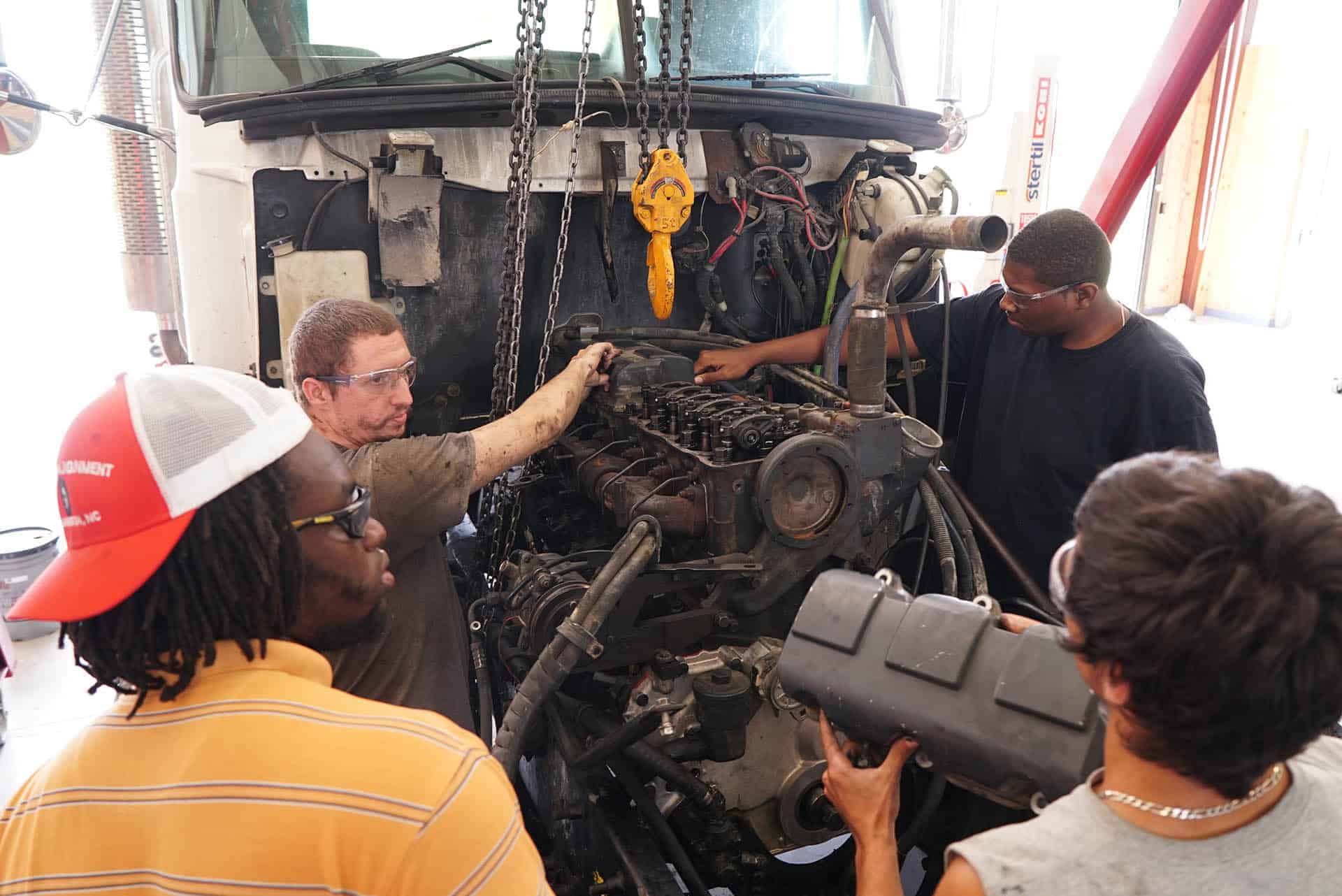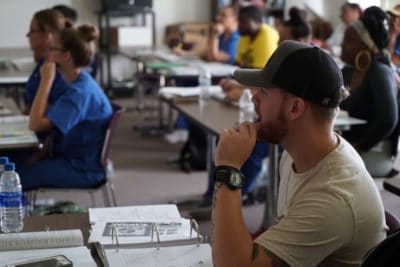Walk through any number of community colleges in North Carolina and you will find a quote from Dr. Dallas Herring prominently displayed on the walls:
“We must take people where they are and carry them as far as they can go.”
Dr. Herring served as the chair of the State Board of Education in 1963 and orchestrated the creation of the community college system. From its inception, he infused into the system the idea that education should be attainable for all — that regardless of location, race, religion, and especially economic status, people who want to better themselves through education can do so. Enrollment in community colleges is one of the simplest and most meaningful ways the system can assess its success in meeting this goal.
Barriers to education shift over time, demanding a flexible community college system that can adapt to changing circumstances. Today, the rising cost of higher education represents a big hurdle for many Americans. As of late 2018, the New York Federal Reserve Consumer Credit Panel and Equifax announced that debt among 18- to 29-year-old Americans surpassed $1 trillion.
With the unemployment rate at record lows, many are choosing a paycheck over choosing to saddle themselves with thousands in debt. As a result, enrollment in community colleges dips when the economy is strong — a trend many community colleges across North Carolina are experiencing right now — and peaks when the economy is struggling. This reality directly impacts the open access principle championed by Dr. Herring.
As we explored in the first part of our enrollment series, declining enrollment at our state’s community colleges is problematic for the state as a whole. Growing economies require an educated population, and a robust community college system expands the number of residents able to get an education.
This is part two of our enrollment series, where we will take a look at how enrollment is calculated at our state’s community colleges. Understanding this is crucial in the management and evaluation of the community college system. Not only does enrollment signal the demand for education in our state, but it also has significant ramifications for how community colleges are staffed, funded, and measured for success.
Breaking down community college enrollment
One of the main ways North Carolina community colleges attract students is below-average tuition rates for residents. For public community colleges across the country, the national average tuition was approximately $3,570 per year for in-state students in 2017-2018. For North Carolina community colleges, the average tuition was approximately $2,432 per year for North Carolina residents. This is possible thanks to contributions from the state.
In 2016, 57 percent of the community college system’s revenue came from state funds. And in 2018-2019, enrollment accounted for 83 percent of total state funding (more on community college funding next week). Unlike public and private four-year universities, community colleges do not cap enrollment as a means to stabilize their spending; denying eligible students is antithetical to the open access principle. As a result, community college enrollment can dip and peak from year to year based on a variety of external factors (like population shifts and unemployment rate), which has a direct impact on the amount of funding for community colleges.
Enrollment at community college is broken into three main categories: curriculum, continuing education, and basic skills courses.
Curriculum education classes are classes typically taken by students who are pursuing their associate or bachelor’s degree. They are designed to be layered with other courses to build knowledge over a longer period in a variety of topic areas. Students pursuing a two-year associate degree must take a certain number of curriculum courses to meet the degree requirements. Students transferring to four-year institutions can get credit for the curriculum courses taken at community colleges, although not all courses transfer to all institutions.
Continuing education courses, or con ed as they are known in the community college world, are designed as stand-alone, non-credit courses that target a specific skill or requirement. A welder might take a con ed class so he can earn a new certificate, or a teacher might take a con ed class as a form of professional development. Policemen, firefighters, and other first responders take con ed classes to get certified and learn the latest developments in fire and rescue. Finally, some take con ed classes to pursue new interests, such as pottery or painting.
The final course type offered at North Carolina community colleges is called basic skills. As the name suggests, basic skills courses focus on elementary literacy skills, GED preparation, and English As A Second Language.
Measuring enrollment: Full-time equivalent
Students do not take a uniform number of classes, and classes can be worth a variety of credits. So universities have developed a unit of measure called full-time equivalent, or FTE, that uses a set number of credits to define a full-time student rather than rely on a traditional headcount. This allows school systems to look at their student body in the aggregate for budget and planning purposes. In plain terms, it allows the school to count multiple part-time students as one full-time student based on the number of credits taken. Schools then base funding on the number of full-time equivalents.
In 2017, the State Board of Community Colleges redefined how FTE is measured for North Carolina’s 58 community colleges. The calculation is based on class hours taken during an academic year. Sixteen hours of “class work,” such as lectures and other classroom instruction, equals one credit hour.
For funding purposes, the State Board defines one FTE as the equivalent of 512 class hours of curriculum courses – 16 hours of “class work,” multiplied by 16 weeks in a semester (256 hours), multiplied by two semesters to equal 512 class hours. This calculation has historically been different for continuing education courses – one FTE equals 688 hours for continuing education classes.
While “class work” forms the basis of the FTE calculations, there are many different types of course work that students take on community college campuses. Time spent in a laboratory or participation in a work-study program all count towards a student’s credit hours but at different rates. The chart below explains how many hours of each course type equals one credit hour:
In line with the principle of open access and flexibility, community college enrollment exists on a sliding scale. Depending on the number of credits a student takes in an academic year, they are either considered a full-time or part-time student. This status affects the types of financial aid they can receive.
Community colleges in North Carolina adhere to the standard enrollment categorizations below. This definition aligns with The National Center of Educational Statistics’ (NCES) definition of an undergraduate FTE as “a student enrolled for 12 or more semester credits, or 12 or more quarter credits, or 24 or more contact hours a week each term.”
By design, community colleges enroll more part-time students than public and private four-year institutions. The American Association of Community Colleges (AACC) found that evaluating institutions based on FTE-count underestimates the number of actual students enrolled at community colleges. AACC concluded that based on their analysis of NCES’s data from 2005 to 2015, “one FTE equals 1.2 students (headcounts) at land-grant public universities which serve ‘traditional’ students, whereas one FTE equals 2.2 students (headcounts) at community colleges nationally.” Therefore, many feel that funding based on FTEs, not actual students, misses many of the costs associated with part-time students, such as career counseling and tutoring.
Dual enrollment: Career and College Promise
In October 2018, AACC estimated that 30 percent of students at community colleges across the country are in a dual enrollment program. Traditional dual enrollment programs allow high school students to enroll in classes at their local community college. For the students, dual enrollment provides a variety of benefits: college experience, access to a broader range of courses, exposure to career paths, and a jumpstart on college credits. Benefits exist for community colleges as well, as dual enrollment programs can sway high school students to pursue an associate degree after graduation who might have otherwise transitioned directly to the job market.
Tuition for dually-enrolled high school students has been a barrier for some states, as high school students are often unable to pay for school themselves. However, the North Carolina General Assembly (NCGA) recognized the potential of dual enrollment and committed to removing this financial hurdle. In 2011, the NCGA passed legislation establishing the Career and College Promise (CCP). The legislation states the mission of CCP is to “offer structured opportunities for qualified high school students to dually enroll in community college courses that provide pathways that lead to a certificate, diploma, degree, or state and industry credentials as well as provide entry-level job skills – tuition-free.” Implementation of CCP went into effect in January 2012.
College and Career Promise offers three different pathways to eligible students: College Transfer, Career and Technical Education, and Cooperative Innovative High Schools. College Transfer Pathways offers tuition-free course credits to currently enrolled juniors and seniors who are planning to obtain an associate or bachelor’s degree after high school. The Career and Technical Education (CTE) pathway works much the same way but for students who plan to complete a certification or diploma program in a technical or career field.
One example of a successful CTE pathway is Project Lead The Way (PLTW). PLTW is designed for students interested in pursuing careers in engineering, engineering technology, or related science fields. PLTW was developed in partnership with Duke University Pratt School of Engineering, which trains all PLTW teachers and school counselors, develops curriculum, and certifies school PLTW programs. PLTW is comprised of four middle school and eight high school courses. And the results speak for themselves; a 2009 study found, “when PLTW students are compared to similar students across all career/technical fields, PLTW students have significantly higher achievement in reading, mathematics and science on a NAEP-referenced assessment.”
The third pathway is to enroll in a Cooperative Innovative High School (CIHS), an umbrella term for early colleges, middle colleges, career academies, and other innovative schools typically located on the campus of a university or community college. There are currently 116 CIHS in North Carolina. Students can apply in eighth grade or transfer to a CIHS if one exists in their district. By way of CCP funding, CIHS students work towards both their high school diploma and an associate degree, certificate, or up to two years’ worth of college credit within five years. For more on CIHS, read our series here.
Tuition for all three pathways are paid for by the state. In 2016-17, CCP reported the equivalent of 21,300 FTEs enrolled in all three pathways. This FTE count equated to $111 million in tuition payments to the NC community college system. Forty-seven percent of the tuition costs were associated with CIHS, 26 percent with the Career Technical Education pathway, and 27 percent with the College Transfer pathway.
Dual enrollment: Community colleges and four-year degree programs
Many students enrolled at community college aspire to transfer to a four-year university to complete their degree. Rather than spend two years taking classes exclusively at a community college awaiting transfer, students are enrolling in classes at both their local community college and at a four-year university simultaneously. NC State has one of the most prominent dual enrollment programs in the state called Community College Collaboration (C3).
C3 is a partnership between NC State and eight community colleges. Students apply for dual enrollment directly after high school graduation or before reaching 30 credit hours at their community college. They then take a mix of classes at both the community college and NC State, where they are designated “non-degree studies” (NDS) students. C3 students have three years to complete their Associate of Arts (A.A.), Associate of Science (A.S.), or Associate of Engineering (A.E.) degree at the partner community college. If students complete their associate degree on time and with at least a 3.0 GPA, they are guaranteed admission to NC State to obtain their bachelor’s degree.
The biggest benefit to a dual enrollment program such as C3 is the cost saving. NC State reserves the C3 program for students from low-to-moderate income households. The C3 program allows NDS students to take NC State classes at the tuition rate of their community college. In-state tuition for one year of full-time community college in North Carolina, on average, is about $2,432, while in-state tuition for NC State is currently $8,896. Under the C3 program, students maintain full-time or part-time enrollment status at their community college while accessing a wider range of classes through NC State at the lower cost of the partner community college.
While community colleges continue to find creative options for their students by way of partnerships, there are no plans on the horizon to change the state’s outsized role in community college funding. With growing investments in programs like the Career and College Promise, the North Carolina General Assembly continues to realize North Carolina’s commitment to investing in higher-education and defraying tuition costs for residents. Under the current funding formula, enrollment calculations and trends will remain at the forefront of policy and funding decisions. Understanding the external factors that affect enrollment and the internal ways in which the state calculates enrollment is therefore key to keeping community colleges open to all and a vital part of North Carolina’s economic growth.



